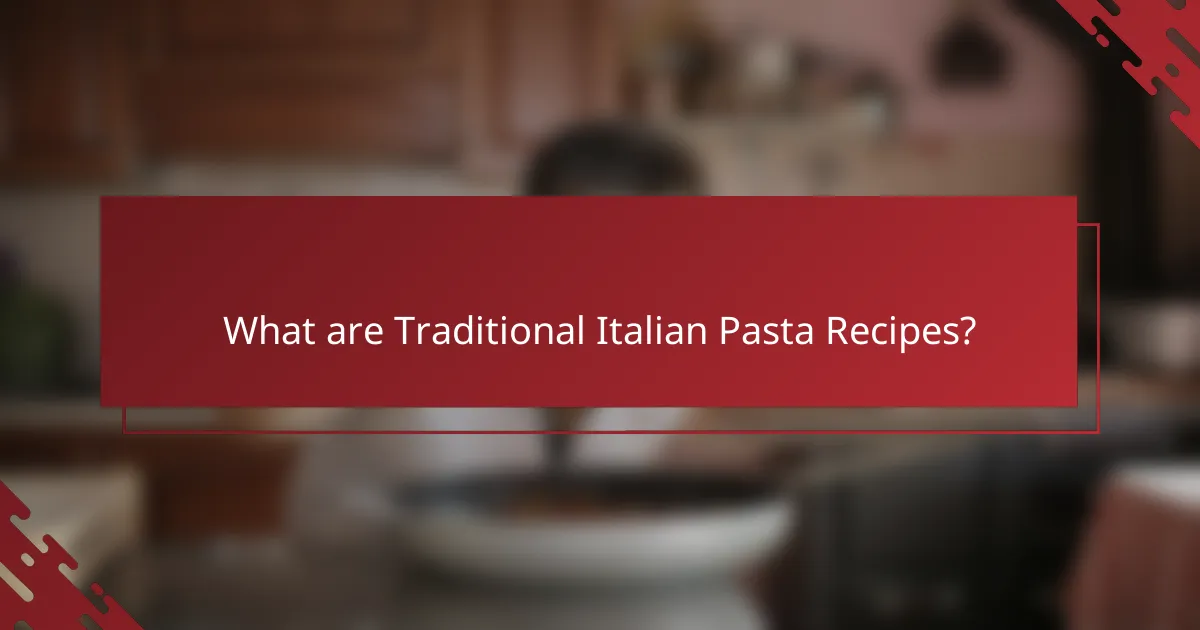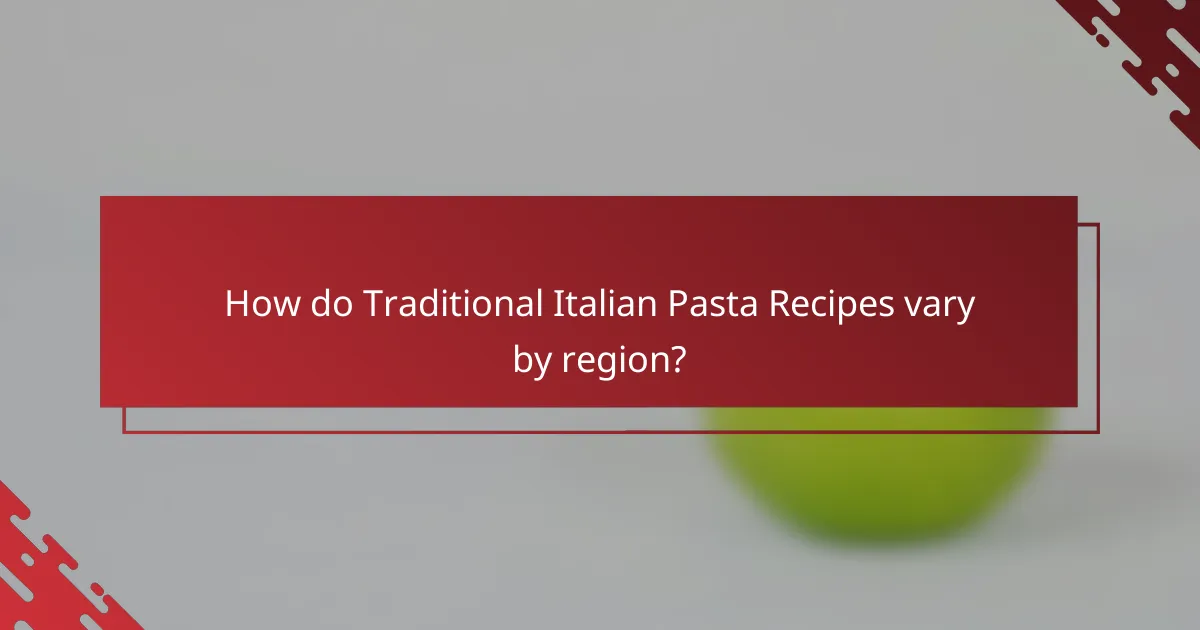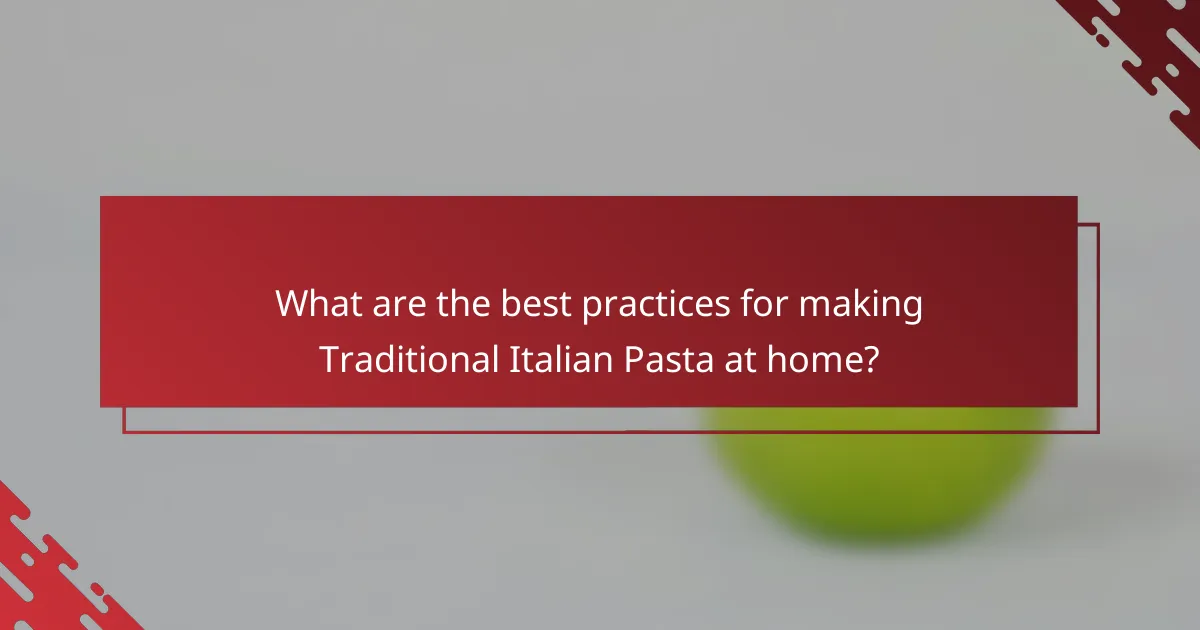Traditional Italian pasta recipes encompass a wide range of dishes that reflect the diverse regional ingredients and cooking techniques found throughout Italy. Key pasta types include spaghetti, fettuccine, and penne, paired with distinctive sauces such as marinara, alfredo, and pesto. Each region contributes unique variations, with Northern Italy favoring creamy sauces and Southern Italy emphasizing tomato-based options. The article explores the historical influences, regional diversity, and authentic cooking methods that shape these beloved recipes, providing insights into the preparation of traditional pasta dishes and their cultural significance.

What are Traditional Italian Pasta Recipes?
Traditional Italian pasta recipes include a variety of dishes that showcase regional ingredients and techniques. These recipes often feature pasta types such as spaghetti, fettuccine, and penne. Common sauces include marinara, alfredo, and pesto, each with distinct flavor profiles.
For example, spaghetti alla carbonara is made with eggs, cheese, pancetta, and pepper. Fettuccine Alfredo combines fettuccine with butter and parmesan cheese. Pesto alla genovese features basil, garlic, pine nuts, olive oil, and parmesan.
Each region of Italy contributes unique recipes, reflecting local traditions and ingredients. Northern Italy often emphasizes creamy sauces, while Southern Italy favors tomato-based sauces. The diversity in recipes highlights Italy’s rich culinary heritage.
How do regional variations influence Traditional Italian Pasta Recipes?
Regional variations significantly influence Traditional Italian Pasta Recipes. Each region in Italy has unique ingredients and cooking methods. For example, Northern Italy often uses creamy sauces, while Southern Italy favors tomato-based sauces. The choice of pasta shapes also varies; orecchiette is popular in Puglia, while tagliatelle is common in Emilia-Romagna. Local ingredients, such as seafood in coastal areas or truffles in the north, enhance the flavors. Historical trade routes and agricultural practices shaped these regional distinctions. Consequently, traditional recipes reflect the culture and resources of each area. This diversity contributes to the rich tapestry of Italian cuisine.
What are the key characteristics of pasta from different regions in Italy?
Pasta from different regions in Italy exhibits unique characteristics based on local ingredients and traditions. In Northern Italy, pasta is often made with egg, resulting in richer varieties like tagliatelle and ravioli. The use of soft wheat flour is common, leading to a tender texture. Central Italy favors durum wheat, producing firmer pasta like spaghetti and fettuccine. This region often incorporates rustic flavors, with sauces featuring tomatoes and olive oil.
Southern Italy is known for its dried pasta, such as orecchiette and cavatappi, typically made from semolina flour. This pasta is often paired with hearty sauces, reflecting the region’s agricultural bounty. Each region’s pasta shapes and sizes also vary, reflecting local culinary traditions. For example, Liguria is famous for trofie, while Puglia is known for its distinctive orecchiette. These regional variations highlight the diversity of Italian pasta, shaped by geography and culture.
How do local ingredients shape regional pasta dishes?
Local ingredients significantly influence regional pasta dishes. The type of flour used in pasta varies by region, reflecting local agricultural practices. For example, durum wheat is prevalent in southern Italy, creating a firmer pasta. In contrast, northern regions may use softer wheat varieties, resulting in a different texture.
Sauces and toppings also depend on local produce. In coastal areas, seafood is a common ingredient, while mountainous regions favor hearty meats and cheeses. Seasonal vegetables often feature prominently in dishes, showcasing the region’s harvest.
Regional pasta shapes often align with local traditions and ingredients. For instance, orecchiette from Puglia is designed to hold chunky sauces, often made from local vegetables. The use of unique herbs and spices further distinguishes regional flavors.
Overall, local ingredients craft distinct identities for pasta dishes, celebrating the diversity of Italian cuisine.
What cooking techniques are essential for preparing Traditional Italian Pasta?
Essential cooking techniques for preparing Traditional Italian Pasta include boiling, sautéing, and tossing. Boiling is crucial for cooking pasta to the desired al dente texture. This technique typically involves using a large pot of salted water. The pasta should be added once the water reaches a rolling boil. Sautéing involves cooking ingredients such as garlic or vegetables in olive oil before combining them with the pasta. This enhances the flavor profile of the dish. Tossing is the final technique, where cooked pasta is mixed with sauce and other ingredients. This ensures even distribution of flavors. Mastery of these techniques is vital for authentic Italian pasta dishes.
How does the choice of cooking method affect the texture of pasta?
The choice of cooking method significantly affects the texture of pasta. Boiling pasta typically results in a soft and tender texture. This method hydrates the pasta evenly, allowing it to expand and cook thoroughly. Alternatively, baking pasta can create a firmer, chewier texture. This method often involves layering with sauces and cheese, leading to a crispy top layer. Sautéing pasta after boiling can enhance its texture, adding a slight crispness. Cooking pasta in a sauce allows it to absorb flavors, which can alter its mouthfeel. Each method produces distinct textures that influence the overall eating experience.
What are the best practices for cooking pasta al dente?
To cook pasta al dente, use a large pot of boiling salted water. Add the pasta and stir occasionally to prevent sticking. Follow the package instructions for cooking time, but check for doneness a minute or two earlier. Al dente pasta should be firm to the bite but not hard. Drain the pasta immediately after cooking to stop the cooking process. Rinse briefly with cold water if not using immediately. Toss with sauce right away for best flavor. Cooking pasta al dente enhances texture and allows it to hold sauce better. This method is traditional in Italian cuisine, ensuring optimal taste and consistency.
Why are flavor profiles important in Traditional Italian Pasta Recipes?
Flavor profiles are crucial in traditional Italian pasta recipes because they determine the overall taste and harmony of the dish. Each region in Italy showcases unique ingredients that contribute specific flavors. For example, basil and tomatoes are prominent in the south, while butter and cream are more common in the north. The balance of flavors enhances the dining experience and reflects regional culinary traditions. Moreover, the right flavor combinations can elevate simple pasta to a gourmet level. Historical practices in Italian cooking emphasize the importance of pairing pasta with complementary sauces and ingredients. This attention to flavor profiles ensures authenticity and preserves cultural heritage in Italian cuisine.
What role do herbs and spices play in enhancing pasta flavors?
Herbs and spices significantly enhance pasta flavors by adding depth and complexity. They introduce aromatic compounds that elevate the overall taste profile. Common herbs like basil and oregano provide freshness, while spices like red pepper flakes add heat. These ingredients can transform a simple dish into a gourmet experience. For example, garlic enhances umami flavors, creating a savory base. Research shows that herbs can also improve the perception of sweetness in dishes. This interplay between herbs, spices, and pasta results in a more balanced and enjoyable meal.
How can sauces complement different types of pasta?
Sauces enhance the flavor and texture of different types of pasta. Each pasta shape has unique characteristics that pair well with specific sauces. For example, long, thin pasta like spaghetti is best complemented by lighter sauces, such as marinara or olive oil-based sauces. These sauces coat the strands evenly without overwhelming them.
In contrast, thicker pasta, such as rigatoni or penne, pairs well with heartier sauces. These sauces, like meat ragù or creamy Alfredo, cling to the pasta’s surface, providing a satisfying bite.
Additionally, stuffed pasta, like ravioli, often benefits from delicate sauces. A simple butter and sage sauce enhances the filling without overshadowing it.
Regional variations also play a role in sauce-pasta pairings. In Northern Italy, creamy sauces are common with broader pasta shapes. In Southern Italy, tomato-based sauces are favored with various pasta types.
This approach to pairing sauces with pasta shapes ensures a balanced and enjoyable dining experience.

How do Traditional Italian Pasta Recipes vary by region?
Traditional Italian pasta recipes vary significantly by region. Each region incorporates local ingredients and traditional cooking methods. For example, in Northern Italy, creamy sauces and rich flavors dominate. Regions like Emilia-Romagna are known for tagliatelle with Bolognese sauce. In contrast, Southern Italy emphasizes olive oil, tomatoes, and fresh vegetables. The Campania region is famous for its spaghetti alle vongole, featuring clams. Additionally, pasta shapes differ regionally; orecchiette is typical in Puglia, while trofie is found in Liguria. Historical influences also shape these variations, with Arab, French, and Spanish cuisines impacting regional dishes. Thus, regional diversity in pasta recipes reflects local culture, ingredients, and history.
What are some iconic pasta dishes from Northern Italy?
Iconic pasta dishes from Northern Italy include Pesto alla Genovese, Tajarin, and Risotto al Nero di Seppia. Pesto alla Genovese is a sauce made from basil, garlic, pine nuts, Parmesan, and olive oil, traditionally served with trofie or trenette pasta. Tajarin is a type of egg pasta, typically served with a rich meat sauce or butter and sage. Risotto al Nero di Seppia is a squid ink risotto, known for its distinct black color and seafood flavor. These dishes reflect the culinary traditions and regional ingredients of Northern Italy.
How do the ingredients in Northern Italian pasta differ from other regions?
Northern Italian pasta typically uses different ingredients compared to other regions. The primary flour used is often a blend of wheat and sometimes buckwheat, particularly in dishes like Pizzoccheri. This contrasts with Southern Italy, where durum wheat is more common. Northern recipes frequently incorporate rich ingredients like cream, butter, and cheese, such as Gorgonzola. In contrast, Southern Italian pasta often emphasizes olive oil, tomatoes, and seafood. Additionally, Northern Italian dishes may include more game meats and mushrooms, reflecting the region’s geography and climate. This regional variation highlights the diverse culinary traditions across Italy.
What unique pasta recipes can be found in Southern Italy?
Unique pasta recipes in Southern Italy include Orecchiette alle Cime di Rapa and Spaghetti alla Puttanesca. Orecchiette alle Cime di Rapa features small, ear-shaped pasta paired with turnip tops. This dish originates from Apulia, a region known for its fresh vegetables. Spaghetti alla Puttanesca combines spaghetti with tomatoes, olives, capers, and garlic. This recipe hails from Naples and reflects the region’s bold flavors. Another notable dish is Pasta alla Norma, made with eggplant, tomatoes, and ricotta salata. It is a Sicilian specialty that highlights local ingredients. Each recipe showcases the unique culinary traditions and ingredients of Southern Italy.
What influences the flavor profiles of Southern Italian pasta dishes?
The flavor profiles of Southern Italian pasta dishes are influenced by regional ingredients, cooking techniques, and cultural traditions. Fresh vegetables like tomatoes, eggplants, and peppers are commonly used, providing vibrant flavors. Olive oil is a staple fat, enhancing richness and depth. Herbs such as basil and oregano contribute aromatic qualities. Seafood is prevalent in coastal areas, adding unique tastes. The use of aged cheeses, like Pecorino, adds saltiness and complexity. Traditional cooking methods, such as slow simmering, deepen flavors. Regional variations reflect local agricultural practices and historical influences. These elements collectively shape the distinctive flavors of Southern Italian pasta dishes.

What are the best practices for making Traditional Italian Pasta at home?
Use high-quality flour, preferably ’00’ flour, for authentic texture. Combine flour with eggs in a well to create a dough. Knead the dough for about 10 minutes until smooth and elastic. Allow the dough to rest for at least 30 minutes, covered with a cloth. Roll the dough thinly using a pasta machine or rolling pin. Cut the dough into desired shapes, such as tagliatelle or lasagna sheets. Cook pasta in boiling salted water for 2-4 minutes, depending on thickness. Taste for doneness before draining. Serve immediately with a sauce that complements the pasta type. These methods align with traditional Italian cooking practices, ensuring authentic results.
How can one select the best ingredients for homemade pasta?
To select the best ingredients for homemade pasta, prioritize high-quality flour, eggs, and salt. Use durum wheat semolina or all-purpose flour for optimal texture. Fresh, large eggs enhance flavor and richness. Sea salt improves taste without overpowering. Consider the pasta type when choosing ingredients; for example, egg pasta requires more eggs. Additionally, regional variations may influence ingredient selection, such as using water instead of eggs in some Southern Italian recipes. The quality of ingredients directly affects the final product’s taste and texture, making careful selection essential for authentic homemade pasta.
What types of flour are recommended for making pasta?
Semolina flour and all-purpose flour are commonly recommended for making pasta. Semolina flour is made from durum wheat and has a high protein content. This gives pasta a firm texture and allows it to hold its shape during cooking. All-purpose flour is versatile and can also be used, though it may result in a softer pasta. Many traditional recipes prefer semolina for its superior texture. The use of these flours is supported by culinary experts and traditional pasta-making practices.
What tips can improve the cooking process for Traditional Italian Pasta?
Use plenty of water when boiling pasta. A large pot with ample water prevents sticking. Salt the water generously before adding pasta. This enhances the flavor of the pasta itself. Stir the pasta occasionally during cooking. This helps maintain separation and prevents clumping. Cook pasta until al dente, typically 1-2 minutes less than package instructions. This texture retains firmness and absorbs sauce better. Reserve some pasta cooking water before draining. This starchy water can be added to sauces for better consistency. Toss pasta with sauce immediately after draining. This allows the pasta to absorb the sauce flavors effectively. Use fresh ingredients for sauces whenever possible. Fresh herbs and quality olive oil elevate the dish’s overall taste.
How can one troubleshoot common pasta cooking issues?
To troubleshoot common pasta cooking issues, identify the problem and apply specific solutions. If pasta is sticky, ensure you use enough water and stir occasionally. For undercooked pasta, increase boiling time by one to two minutes. If overcooked, reduce cooking time next time and check doneness earlier. If pasta is bland, enhance flavor with salt in the cooking water. For uneven cooking, ensure pasta is spread evenly in the pot. If pasta clumps, rinse it briefly with cold water after draining to separate. Each of these solutions addresses specific cooking challenges effectively.
What tools are essential for preparing Traditional Italian Pasta?
Essential tools for preparing Traditional Italian Pasta include a pasta machine, rolling pin, and a sharp knife. A pasta machine ensures even thickness and uniformity in pasta sheets. A rolling pin is useful for hand-rolling dough to the desired thickness. A sharp knife is needed for cutting pasta shapes accurately. Additionally, a mixing bowl is essential for combining ingredients. A clean surface or countertop is necessary for kneading the dough. Finally, a pot for boiling water is required to cook the pasta. These tools are foundational for achieving authentic Italian pasta.
Which kitchen equipment is most useful for making fresh pasta?
A pasta machine is the most useful kitchen equipment for making fresh pasta. It allows for consistent thickness and texture in the dough. A rolling pin is also essential for those who prefer a manual approach. A sharp knife or pasta cutter is necessary for cutting the pasta into desired shapes. Additionally, a mixing bowl is required for combining ingredients. Measuring cups and spoons ensure accurate ingredient ratios. Lastly, a clean surface for rolling out the dough is crucial. These tools collectively facilitate the process of making fresh pasta effectively.
Traditional Italian Pasta Recipes encompass a wide range of dishes that reflect regional ingredients and culinary techniques across Italy. The article explores how regional variations influence pasta types, sauces, and cooking methods, highlighting key characteristics and local ingredients that shape distinct flavor profiles. Essential cooking techniques for preparing authentic pasta, such as boiling and sautéing, are discussed, alongside best practices for achieving the ideal al dente texture. Additionally, the article addresses common cooking issues and essential tools needed for making traditional pasta at home, providing a comprehensive overview of Italy’s rich culinary heritage.